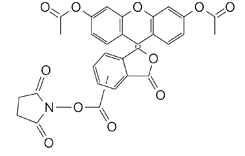 | ||
Carboxyfluorescein diacetate succinimidyl ester (CFDA-SE) is a cell permeable dye generally used in animal cell proliferation research. High concentrations of the dye are toxic to animal cells, however concentrations in the region of 10 micromolar are typically sufficient to give strong staining with minimal cell death.
CFDA-SE enters cells by diffusion and is cleaved by intracellular esterase enzymes to form an amine-reactive product, CFSE. This product produces a detectable fluorescence and covalently binds to intracellular lysine residues and other amine sources. Most cell types will excrete a proportion of the dye over the course of the first 24–48 hours following staining. Dye levels should thereafter remain relatively stable in non-dividing cells. If a stained cell divides, the dye is divided equally between the two daughter cells, resulting in both new cells having a CFDA-SE concentration approximately 50% that of the mother cell. A cell stained with CFDA-SE can be kept in culture for several days and fluorescence is detectable in cells following up to 8 successive cell divisions. Fluorescence is typically detected using a flow cytometer on the FL1 detector, with each resulting fluorescent peak representing another round of cell division. The area of each peak is representative of the number of cells in a given division cycle. The staining works best with relatively homogeneous cell populations.
CFDA-SE is often erroneously referred to as CFSE, even in scientific literature.
